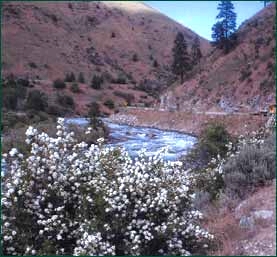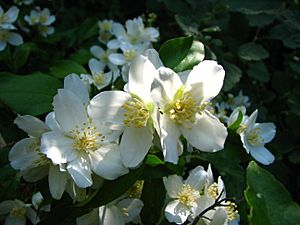Philadelphus lewisii facts for kids
Quick facts for kids Philadelphus lewisii |
|
|---|---|
 |
|
| Conservation status | |
| Scientific classification | |
| Genus: |
Philadelphus
|
| Species: |
lewisii
|
Philadelphus lewisii, also known as Lewis' mock-orange, is a type of deciduous shrub. This means it's a woody plant that loses its leaves every autumn. It grows naturally in western North America. You can find it from northern California up to southern British Columbia, and east to Idaho and Montana.
This plant was first collected by the famous explorer and scientist Meriwether Lewis in 1806. He found it during the Lewis and Clark Expedition. The plant was named Philadelphus lewisii in his honor. People sometimes call it Gordon's mockorange, Indian arrowwood, or syringa. But be careful, "syringa" usually refers to lilacs, which are different plants!
Contents
What Does Lewis' Mock-Orange Look Like?
This shrub has a rounded shape. It usually grows to be about 1.5 to 3 meters (5 to 10 feet) tall. Its new stems are red, but they turn gray as they get older. The bark on older stems peels off in small pieces.
The leaves grow opposite each other on the stem. They are usually oval-shaped and about 3 to 5 centimeters (1 to 2 inches) long. Their edges can be smooth or slightly jagged. The leaves are light green and feel a bit rough.
Flowers and Fruit
The plant produces beautiful flowers in groups at the ends of its long stems. Each flower has four white petals that can be up to 4 centimeters (1.5 inches) long. They also have many yellow parts called stamens. When the plant is in full bloom, it's covered in a huge number of white flowers.
These flowers have a strong, sweet smell. It's a bit like orange blossoms, with a hint of pineapple. After the flowers, the plant grows small, hard fruits. These fruits are called capsules. They are about 1 centimeter (0.4 inches) long and have woody, pointed "wings." Inside, they hold many small brown seeds. This plant is very tough and can grow in many different climates.
How Did Native Americans Use This Plant?
Native American tribes used Lewis' mock-orange for many different things. The wood is very hard, so it was good for making tools. They used it for hunting and fishing tools, and even for snowshoes. They also made pipes and furniture from the wood.
The leaves and bark of the plant contain a substance called saponin. When mixed with water, this made a mild soap. Native Americans also used the stems to make arrows, bows, combs, and cradles for babies. The flowers were sometimes used to make perfumes and teas.
Growing Lewis' Mock-Orange
Lewis' mock-orange is a great plant for gardens. It likes a lot of sun, but can also grow in partial shade. It doesn't need much water once it's established. This means it's good for xeriscaping, which is a way of gardening that uses plants needing little water. It adds beautiful flowers and a sweet smell to any landscape.
What Are Mock-Orange Hybrids?
Sometimes, different types of plants are crossed to create a new plant. This new plant is called a hybrid. The Waterton Mockorange, known as Philadelphus lewisii 'Waterton', is a hybrid of Lewis' mock-orange.
This special hybrid was created in Canada. It's also good at handling dry conditions and is great for xeriscaping. It grows to be about 1.2 to 1.8 meters (4 to 6 feet) tall. This plant can also grow in many different climates.
A man named Augustus Griffin noticed this plant growing in what is now Waterton Lakes National Park in Canada back in 1933. Griffin was a pioneer in growing plants. He collected, grew, and crossed many different plants.
Symbolism
Philadelphus lewisii is an important plant in the United States. It is the official state flower of Idaho.
Images for kids






